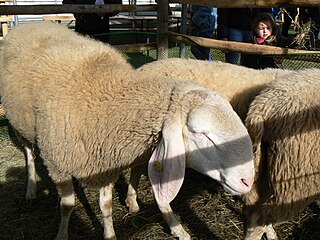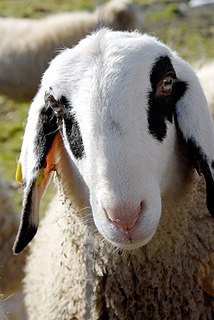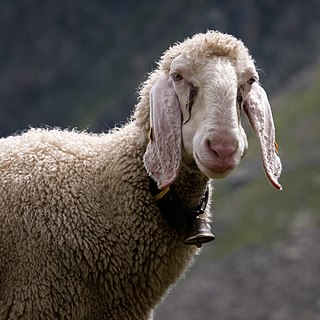Related Research Articles
Uda or UDA may refer to:

The North Ronaldsay or Orkney is a breed of sheep from North Ronaldsay, the northernmost island of Orkney, off the north coast of Scotland. It belongs to the Northern European short-tailed sheep group of breeds, and has evolved without much cross-breeding with modern breeds. It is a smaller sheep than most, with the rams (males) horned and ewes (females) mostly hornless. It was formerly kept primarily for wool, but now the two largest flocks are feral, one on North Ronaldsay and another on the Orkney island of Auskerry. The Rare Breeds Survival Trust lists the breed as "vulnerable", with fewer than 600 registered breeding females in the United Kingdom.

The Blackface or Scottish Blackface is a British breed of sheep. It is the most common sheep breed of the United Kingdom. Despite the name, it did not originate in Scotland, but south of the border.

The Jacob is a British breed of domestic sheep. It combines two characteristics unusual in sheep: it is piebald—dark-coloured with areas of white wool—and it is often polycerate or multi-horned. It most commonly has four horns. The origin of the breed is not known; broken-coloured polycerate sheep were present in England by the middle of the seventeenth century, and were widespread a century later. A breed society was formed in 1969, and a flock book was published from 1972.

The Suffolk is a British breed of domestic sheep. It originated in the late eighteenth century in the area of Bury St. Edmunds in Suffolk, as a result of cross-breeding when Norfolk Horn ewes were put to improved Southdown rams. It is a polled, black-faced breed, and is raised primarily for its meat. It has been exported to many countries, and is among the most numerous breeds of sheep worldwide.
The Hebridean is a breed of small black sheep from Scotland, similar to other members of the Northern European short-tailed sheep group, having a short, triangular tail. They often have two pairs of horns. They were often formerly known as "St Kilda" sheep, although unlike Soay and Boreray sheep they are probably not in fact from the St Kilda archipelago.

The Dorset Horn is an endangered British breed of domestic sheep. It is documented from the seventeenth century, and is highly prolific, sometimes producing two lambing seasons per year. Among British sheep, it is the only breed capable of breeding throughout the winter.

The Boreray, also known as the Boreray Blackface or Hebridean Blackface, is a breed of sheep originating on the St Kilda archipelago off the west coast of Scotland and surviving as a feral animal on one of the islands, Boreray. The breed was once reared for meat and wool, but is now used mainly for conservation grazing. The Boreray is one of the Northern European short-tailed sheep group of breeds.
The West African Dwarf or Djallonké is an African breed or group of breeds of domestic sheep. It is the dominant breed of West and Central Africa. This breed is primarily raised for meat.

The Bergamasca is a breed of domestic sheep from the mountainous part of the province of Bergamo, in Lombardy in northern Italy. It originates from the area of the Val Brembana and the Val Seriana valleys, and is particularly associated with the plateau of Clusone. By the beginning of the 20th century it had spread through much of Lombardy; it is now raised in most parts of mainland Italy, particularly the province of Teramo in Abruzzo, where more than 80% of the registered stock are kept. The Bergamasca is also present in Brazil, Serbia and Venezuela. It is raised principally for meat, and is often used for cross-breeding with other meat breeds to improve meat yield. In Lombardy, it is traditionally raised by transhumant management: the herds spend the summers on the alpine pasture, and over-winter in the Po valley.

The Jezersko–Solčava is a breed of domestic sheep from the eastern Alpine region of Europe. Until the outbreak of the First World War it was the most numerous sheep breed in southern Carinthia, in Friuli and in Slovenia. Its name derives from the regions of Jezersko and of Solčava, formerly in the Austrian Empire, now in Slovenia. It is raised also in parts of Austria, Germany and Italy; a small number were imported to Serbia in 1991. It may also be known as the German: Kärntner Brillenschaf, Seeländer Schaf or Villnösser Schaf, or as the Slovene: Jezersko-Solčavska Ovca.

The Comisana, also known as Faccia Rossa and Lentinese, is an Italian breed of domestic sheep indigenous to central and northern areas of the Mediterranean island of Sicily. Its name derives from that of the comune of Comiso, in the province of Ragusa. It is raised principally in the provinces of Caltanissetta, Enna and Palermo, but is found in many other Italian provinces and has also been exported to other Mediterranean countries.
The Ciavenasca is a breed of small domestic sheep from the province of Sondrio, in Lombardy in northern Italy. It is raised in the mountainous terrain of the Val San Giacomo, the Val Bregaglia and the Valchiavenna, from which the name of the breed derives. It is raised only for meat; the wool is of very poor quality, and the milk is sufficient only for the lambs. It is one of the forty-two autochthonous local sheep breeds of limited distribution for which a herdbook is kept by the Associazione Nazionale della Pastorizia, the Italian national association of sheep-breeders.
The Finarda is a breed of large domestic sheep from the regions of Lombardy and Piemonte in northern Italy. It is heavy breed raised mainly for meat, although it also yields 4–6 kg of wool per year. It results from cross-breeding the Bergamasca and Biellese breeds. It is one of the forty-two autochthonous local sheep breeds of limited distribution for which a herdbook is kept by the Associazione Nazionale della Pastorizia, the Italian national association of sheep-breeders. However, in 2008 the herdbook was empty, and may in fact never have been activated. Most data for the breed dates from 1983.
The Garfagnina Bianca is a breed of small domestic sheep from the historic area of the Garfagnana, the mountainous northern part of the province of Lucca, in Tuscany in central Italy. It shares common origins with the Cornella Bianca, Massese and Zerasca. It is one of the forty-two autochthonous local sheep breeds of limited distribution for which a herdbook is kept by the Associazione Nazionale della Pastorizia, the Italian national association of sheep-breeders.
The Istriana or Carsolina, Croatian: 'Istarska Ovca', Slovene: 'Istrska Pramenka', is a breed of domestic sheep from Istria and the Karst regions of the northern Adriatic, from north-east Italy to Croatia and Slovenia.
The Lamon or Lamonese is a breed of sheep from the comuni of Lamon and Sovramonte in the province of Belluno, in the Veneto in north-east Italy. The area is known as the Feltrino, from the town of Feltre, and the breed may also be referred to as the Feltrina. It was formerly widely distributed in the Veneto and the Trentino, and as far as the province of Mantova in Lombardy. In the 1950s there was an attempt to increase the size by cross-breeding with the Bergamasca; there was also some cross-breeding with the Padovana and the now extinct Trentina. The Lamon is one of the forty-two autochthonous local sheep breeds of limited distribution for which a herdbook is kept by the Associazione Nazionale della Pastorizia, the Italian national association of sheep-breeders.
The Pusterese is a breed of domestic sheep from the autonomous province of Bolzano in northern Italy. It may also be called the Pustera gigante, Nobile di Badia or Gadertaler. It is raised mainly in the Val Pusteria (Pustertal), from which it takes its name, and in the Val Gardena; it has been reported also from the province of Belluno. The origins of the breed are unclear; it probably originates from the Tirol, but has also been influenced by the Lamon. It is one of the forty-two autochthonous local sheep breeds of limited distribution for which a herdbook is kept by the Associazione Nazionale della Pastorizia, the Italian national association of sheep-breeders.
The Varesina is a rare breed of domestic sheep from the province of Varese in Lombardy, in northern Italy. It originates from the area of Biandronno and Travedona; members of the breed have been identified in the comuni of Albizzate and Arcisate. The Varesina is closely related to the Bergamasca and the Biellese, but is smaller. It is one of the forty-two autochthonous local sheep breeds of limited distribution for which a herdbook is kept by the Associazione Nazionale della Pastorizia, the Italian national association of sheep-breeders.

The Tiroler Bergschaf or Pecora Alpina Tirolese is a breed of domestic sheep from the mountainous Tyrol area of Austria and Italy. The name means "Tyrolean mountain sheep". It is raised throughout Austria and in the autonomous province of Bolzano in Italy. It results from cross-breeding between the Tiroler Steinschaf of the Tyrol with the Italian Bergamasca breed from the area of Bergamo. This is variously reported as having taken place in the first half of the 19th century and after the Second World War.
References
- ↑ General Breed Information on Uda sheep, Domestic Animal Genetic Resources Information System (DAGRIS), ILRI (accessed 28 September 2013)
- 1 2 "Uda," Oklahoma State University Beeds of Livestock: Breeds of African Origin (accessed 1 October 2013)